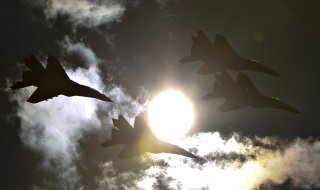Russian Fighter Jets Scrambled In Two Different Incidents With U.S. Aircraft
A Cold War-era fighter jet was reported to have peacefully intercepted and escorted the American aircraft and no violations of the state border were allowed.
Russian pilots reportedly logged quite a few hours already this month to intercept and track U.S. aircraft near Russian airspace. Last week three Su-35S fighters were scrambled to shadow a U.S. B-1B Lancer bomber over the Sea of Okhotsk west of Russia's Kamchatka Peninsula in the far western Pacific Ocean.
State media reported that Russian airspace control systems detected the “air target” over the neutral waters of the Pacific Ocean approaching the state border at approximately 7 p.m. local time on August 7.
“Three Su-35S fighters from the Eastern Military District’s air defense quick reaction alert forces were scrambled one by one to intercept the target, which they identified as a US Air Force B-1B strategic bomber and consistently shadowed it over the Sea of Okhotsk,” a spokesperson for the National Defense Control Center told Tass. “After the US plane moved away from Russia’s state border, the Russian fighters safely returned to their home airfield.”
The Russian Sukhoi Su-35S is the top Russian air-superiority fighter in service today, and the aircraft represents the pinnacle of fourth-generation jet fighter design. It will remain so until Russia succeeds in bringing its fifth-generation PAK-FA stealth fighter into production.
The U.S. Air Force’s B-1B bombers have been conducting missions in the region, working with American partners including Japan. In May, two B-1B Lancers took part in a twenty-four-hour drill—and it isn’t clear at this time if last week’s flight was another such exercise.
The entire flight of the three Su-35S fighters was conducted in strict compliance with the international rules of using the airspace added Russia’s National Defense Control Center.
Across Asia on the other side of Russia, a Sukhoi Su-27 fighter was also scrambled to intercept two reported “U.S. spy planes” over the Black Sea, the National Defense Control Center claimed on Monday. Russian airspace control systems detected two air targets, identified as a U.S. Air Force RC-135 reconnaissance plane and a U.S. Navy P-8A Poseidon maritime patrol aircraft, over the neutral waters of the Black Sea approaching Russia's state border.
“A Su-27 fighter of the Southern Military District’s air defense quick reaction alert forces was scrambled to intercept the targets,” said the National Defense Control Center to Tass. “After the spy planes moved away from Russia’s state border, the Russian fighter safely returned to its home airfield.”
As with the flights in Russia’s Far East, the Su-27—a Cold War-era fighter jet—was reported to have peacefully intercepted and escorted the American aircraft and no violations of the state border were allowed. Monday’s flight came just a day after another Su-27, also from the Southern Military District’s air defense quick reaction alert forces, was scrambled to intercept the United States to intercept a U.S. Navy EP-3E ARIES electronic surveillance aircraft.
It is unclear how close the Russian fighter came to the American aircraft. However, there have been past incidents. In January of 2018, there was a new accident when a Su-27 passed an EP-3 at a reported distance of just five feet, and a similar close call occurred involving a Su-27 in November of the same year.
The U.S. Navy currently operates eleven of the signals-intelligence aircraft.
Peter Suciu is a Michigan-based writer who has contributed to more than four dozen magazines, newspapers and websites. He is the author of several books on military headgear including A Gallery of Military Headdress, which is available on Amazon.com.
Image: Reuters

